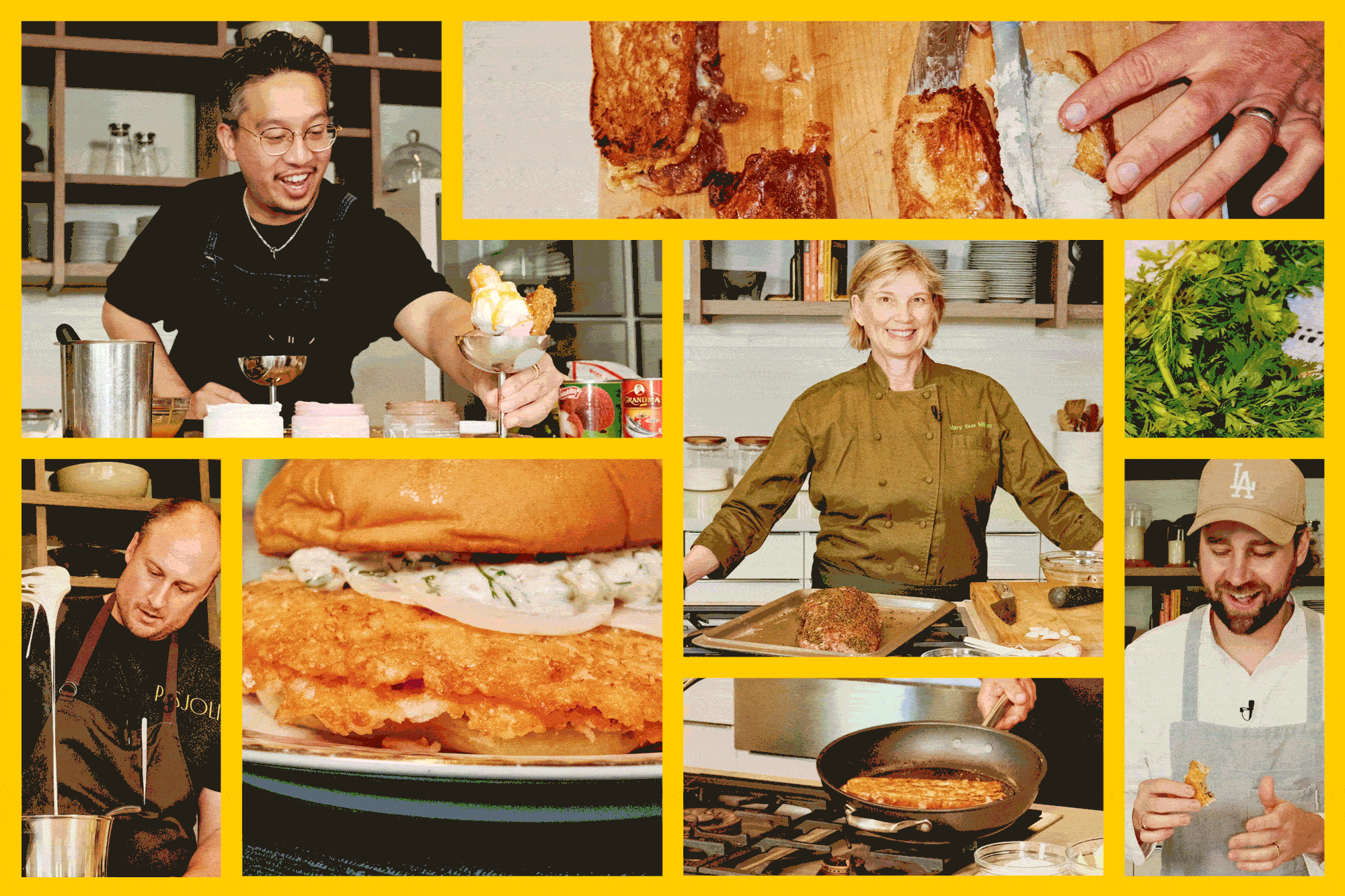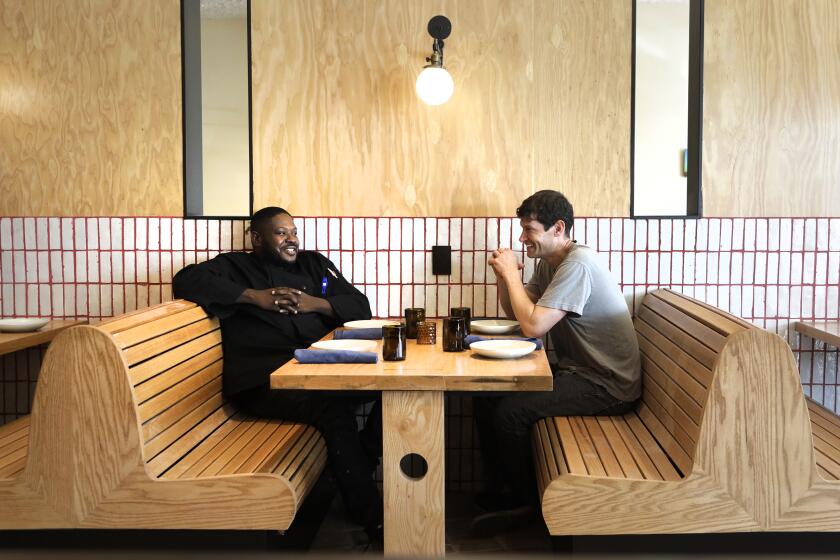University Chefs Step Up a Grade for Big Test
Mark Baida is an award-winning chef with an edgy elan, traits reflected in the two silver medals decorating his office wall at USC and the pairs of silver rings adorning his ears.
On a busy afternoon, he took a break from the kitchen to talk about chicken, describing in delectable detail the recipe that earned him his latest medal in an American Culinary Federation-sanctioned competition:
Sauteed breast of chicken with black-truffle and pine-nut chicken sausage; celery root-Yukon potato puree with cambozola cheese; peppered bacon and apple compote; rosemary-scented carrots; and French apple brandy sauce.
“The truffles bring it down more to an earthy, rustic, simple dish,” Baida said, dreamily.
But not simple enough to prepare for his main customers: the thousands of students who eat at USC’s dining halls, for which Baida is executive chef. Fixing vittles that fancy for legions of hungry Trojans would take too many cooks too many hours.
Besides, the diners might prefer the school’s No. 1 perennial choice, deep-fried chicken nuggets.
When it comes to high-end cuisine in higher education, Baida and other college chefs say, a couple truths remain elementary:
Their most creative concoctions often never end up on the tray line. And even when students are offered entrees as nutritious as they are tasty, many opt for the greasier grub that more closely resembles their favorite fast food.
This week, six of Baida’s colleagues -- he just missed the cut -- are scheduled to don toques in Toronto as finalists in the sixth annual Culinary Challenge of the National Assn. of College and University Food Services. The winner will be named Thursday. The chicken-themed contest -- no nuggets are in the running -- is part of a quality drive that college officials say has made chow in academia better than ever, to the point that universities promote their chefs and menus in enrollment pitches to prospective students.
College food is an estimated $15-billion industry, and one that has tried to get hip to health-conscious changes in student appetites, even as it contends with an ongoing assault from the likes of McDonald’s and Burger King.
Largely replacing the fresh-from-a-can cafeteria gruel of lore is such fare as sushi, stir-fried tofu and hard-carved helpings of Jamaican jerked pork loin.
But far less common in dining halls are the dishes that score medals in the association’s regional and national cook-offs, which are designed to sharpen chefs’ skills.
The reasons include the logistical obstacles and prohibitive cost of producing gourmet meals on a dormitory scale. Then there is the question of whether the student palate will know when dinner isn’t just warm, but haute.
“Sounds like it would be good,” said USC student Jack Waldron, when told of Baida’s chicken-and-truffle masterwork.
Waldron was polishing off an early supper at the Parkview Restaurant dining hall. He had chicken breast, potatoes and salad, but with a side of Lucky Charms cereal and chocolate cake for dessert.
Tablemate Brian Trageser dug into a three-course feast of nachos, French fries and ice cream. He expressed surprise that the people feeding him were bagging prizes.
“They’re pretty much putting out the same stuff over and over here,” he said. “I didn’t even know we had an executive chef.”
But he and his buddies did know about Baida’s chicken nuggets. “They’re gourmet chicken nuggets,” said student Dan Fullerton, eyes narrowed in blissful appreciation. There were sighs of agreement all around.
At USC’s Town and Gown kitchen, where he focuses on catered meals for special events, Baida fumed about the insatiable craving for chicken nuggets. “That’s a pet peeve I have,” he said. “If it was my way, I’d eliminate them.”
His frustration is shared over stoves from the University of Washington to the University of Massachusetts, and many campuses in between.
Finalists in the Toronto showdown, along with other chefs, said the most popular dishes in their eateries are chicken nuggets -- a.k.a. chicken strips or chicken tenders -- and pizza.
“I hate to say it, but it’s true,” said Laura Strunk, a finalist who is catering chef at Notre Dame University.
Strunk’s competition entry is sauteed breast of chicken sambuca served on a bed of braised lentils, accompanied by a pistachio mousseline with caramelized carrots and fennel.
It won’t be found in any Fighting Irish dorms.
“You could probably do this for about 25 people,” Strunk said. “It probably would be a little labor-intensive.”
Peter Imranyi, chef manager for Rutgers University, cited the same problem with his Toronto bid. He’s pan-roasting a Frenched chicken breast with a braised potato, leek and Swiss chard ragout, shaved fennel, celery root and a sherry-apple emulsion.
“It’s designed more for an a la carte menu,” he said.
University of Washington sous chef Jacob Moyer said he also doesn’t have the means to mass-produce his finalist recipe for students. But if he did, would it be a hit?
“They like food that mom cooked,” Moyer said of students. “They’re not looking for seared foie gras ... and that’s the type of stuff we’re preparing for this competition.”
His Toronto repast is breast of chicken with Parmesan crust, pan-fried semolina gnocchi and warm tomato vinaigrette.
Jonathan Lee, who was about to graduate from the University of Washington, said he hadn’t heard of the chefs contest but applauds the notion that it “keeps them on their toes.”
Lee said the food on campus is decent, and the occasional offering of Jamaican jerked chicken with mango salsa is a treat. Even so, he lamented, “traditional greasy foods” are still staples.
“They try to make it a little more healthy than what we get at Taco Bell,” Lee said.
A proliferation of such franchises on and near campuses has helped motivate chefs to cleave from the “mystery meat” past of college meal plans, which can cost several thousand dollars a year.
“We have to be just as competitive if we’re going to stay in business with every restaurant in the private sector,” said University of Montana executive chef Thomas Siegel, also a finalist. “Students don’t have to buy the meal plan.”
Siegel’s Toronto dish is lobster mushroom dusted chicken roulade of fig chutney, finished with pomegranate tomato sauce.
He said it could be adapted for dorm kitchens, perhaps by dispensing with the tricky roulade -- stuffing each chicken portion with the chutney -- and instead tucking the fig filling under an airline-style chicken breast.
“I just haven’t figured out how to do it yet,” Siegel said.
Likewise, Rice University sous chef Edward Castillo said his Toronto entry -- pan-seared chicken supreme with porcini mushroom sauce -- “wouldn’t make sense” as a dorm dish, because of volume and preparation time. “We served 60 pounds of chicken today,” he said. “We get a lot of athletes over here.”
And if he somehow could plate up that much chicken supreme, Castillo said, students might “look at it and say, ‘OK, I don’t need this.’ ”
At the University of Massachusetts’ Amherst campus, head cook Anthony Jung said students have no idea how dyspeptic things used to be.
“Everything was brown,” he said of the food in the mid-1990s, when he was in school.
For Toronto, Jung is doing chicken breast stuffed with leek mousseline, Parmesan potato puree, ragout of wild mushrooms and batonnets of summer squash. He said he lacks the staff to make it for his students, but has reason to believe they’d whale it down.
“In the five years I’ve been here, we haven’t had a food fight,” Jung said. “I guess that’s a good sign. People would rather eat it than throw it.”
More to Read
Eat your way across L.A.
Get our weekly Tasting Notes newsletter for reviews, news and more.
You may occasionally receive promotional content from the Los Angeles Times.











